Selectivity of Oxygen Evolution Reaction on Carbon Cloth-Supported δ-MnO2 Nanosheets in Electrolysis of Real Seawater
Abstract
1. Introduction
2. Results and Discussions
3. Materials and Methods
3.1. Pretreatment of Carbon Cloth
3.2. Preparation of MnO2/CC
3.3. Preparation of X-MnO2/CC (X = Fe, Co, Ni)
3.4. OER Selectivity Investigation
3.5. Physical Characterizations
3.6. Electrochemical Characterizations
4. Conclusions
Supplementary Materials
Author Contributions
Funding
Institutional Review Board Statement
Informed Consent Statement
Data Availability Statement
Conflicts of Interest
Sample Availability
References
- Roger, I.; Shipman, M.A.; Symes, M.D. Earth-abundant catalysts for electrochemical and photoelectrochemical water splitting. Nat. Rev. Chem. 2017, 1, 0003. [Google Scholar] [CrossRef]
- Yan, Y.; Xia, B.Y.; Zhao, B.; Wang, X. A review on noble-metal-free bifunctional heterogeneous catalysts for overall electrochemical water splitting. J. Mater. Chem. A 2016, 4, 17587–17603. [Google Scholar] [CrossRef]
- Han, L.; Dong, S.; Wang, E. Transition-Metal (Co, Ni, and Fe)-Based Electrocatalysts for the Water Oxidation Reaction. Adv. Mater. 2016, 28, 9266–9291. [Google Scholar] [CrossRef] [PubMed]
- Chatenet, M.; Pollet, B.G.; Dekel, D.R.; Dionigi, F.; Deseure, J.; Millet, P.; Braatz, R.D.; Bazant, M.Z.; Eikerling, M.; Staffell, I.; et al. Water electrolysis: From textbook knowledge to the latest scientific strategies and industrial developments. Chem. Soc. Rev. 2022, 51, 4583–4762. [Google Scholar] [CrossRef]
- Urban, J.J. Emerging Scientific and Engineering Opportunities within the Water-Energy Nexus. Joule 2017, 1, 665–688. [Google Scholar] [CrossRef]
- Jiang, S.; Suo, H.; Zhang, T.; Liao, C.; Wang, Y.; Zhao, Q.; Lai, W. Recent Advances in Seawater Electrolysis. Catalysts 2022, 12, 123. [Google Scholar] [CrossRef]
- Yu, L.; Zhu, Q.; Song, S.; McElhenny, B.; Wang, D.; Wu, C.; Qin, Z.; Bao, J.; Yu, Y.; Chen, S.; et al. Non-noble metal-nitride based electrocatalysts for high-performance alkaline seawater electrolysis. Nat. Commun. 2019, 10, 5106. [Google Scholar] [CrossRef]
- Kuang, Y.; Kenney, M.J.; Meng, Y.; Hung, W.H.; Liu, Y.; Huang, J.E.; Prasanna, R.; Li, P.; Li, Y.; Wang, L.; et al. Solar-driven, highly sustained splitting of seawater into hydrogen and oxygen fuels. Proc. Natl. Acad. Sci. USA 2019, 116, 6624–6629. [Google Scholar] [CrossRef]
- Song, H.J.; Yoon, H.; Ju, B.; Lee, D.-Y.; Kim, D.-W. Electrocatalytic Selective Oxygen Evolution of Carbon-Coated Na2Co1–xFexP2O7 Nanoparticles for Alkaline Seawater Electrolysis. ACS Catal. 2019, 10, 702–709. [Google Scholar] [CrossRef]
- Dionigi, F.; Reier, T.; Pawolek, Z.; Gliech, M.; Strasser, P. Design Criteria, Operating Conditions, and Nickel-Iron Hydroxide Catalyst Materials for Selective Seawater Electrolysis. ChemSusChem 2016, 9, 962–972. [Google Scholar] [CrossRef]
- Yu, L.; Wu, L.; McElhenny, B.; Song, S.; Luo, D.; Zhang, F.; Yu, Y.; Chen, S.; Ren, Z. Ultrafast room-temperature synthesis of porous S-doped Ni/Fe (oxy)hydroxide electrodes for oxygen evolution catalysis in seawater splitting. Energy Environ. Sci. 2020, 13, 3439–3446. [Google Scholar] [CrossRef]
- Liu, J.; Liu, X.; Shi, H.; Luo, J.; Wang, L.; Liang, J.; Li, S.; Yang, L.-M.; Wang, T.; Huang, Y. Breaking the scaling relations of oxygen evolution reaction on amorphous NiFeP nanostructures with enhanced activity for overall seawater splitting. Appl. Catal. B Environ. 1208, 302, 120862. [Google Scholar] [CrossRef]
- Liu, S.; Ren, S.; Gao, R.-T.; Liu, X.; Wang, L. Atomically embedded Ag on transition metal hydroxides triggers the lattice oxygen towards sustained seawater electrolysis. Nano Energy 2022, 98, 107212. [Google Scholar] [CrossRef]
- Lu, J.; Li, C.; Wang, H.; Ji, S.; Wang, X.; Wang, R. How to get to best oxygen evolution behavior from the electrolysis practice of the seawater. Int. J. Hydrog. Energy 2021, 46, 12936–12943. [Google Scholar] [CrossRef]
- Sun, H.; Xu, X.; Song, Y.; Zhou, W.; Shao, Z. Designing High-Valence Metal Sites for Electrochemical Water Splitting. Adv. Funct. Mater. 2021, 31, 2009779. [Google Scholar] [CrossRef]
- Sang, S.; Meng, H.; Shi, Y.; Yu, H.; Fan, Z.; Sun, D. Preparation of oxygen evolution anode for electrolytic seawater. Chinese Mechanical Engineering Society Surface Engineering Branch. In Proceedings of the 7th National Surface Engineering Academic Conference and the 2nd Surface Engineering Youth Academic Forum, Wuhan, China, 10 October 2008; pp. 327–330. [Google Scholar]
- Vos, J.G.; Wezendonk, T.A.; Jeremiasse, A.W.; Koper, M.T.M. MnOx/IrOx as Selective Oxygen Evolution Electrocatalyst in Acidic Chloride Solution. J. Am. Chem. Soc. 2018, 140, 10270–10281. [Google Scholar] [CrossRef]
- Ma, X.; Wang, Z.N.; Wang, Z.H.; Cui, M.Q.; Wang, H.; Ren, J.W.; Karimzadeh, S. Adjusting grain boundary within NiCo2O4 rod arrays by phosphating reaction for efficient hydrogen production. Nanotechnology 2022, 33, 245604. [Google Scholar] [CrossRef]
- Liu, J.; Jiang, J.; Cheng, C.; Li, H.; Zhang, J.; Gong, H.; Fan, H.J. Co3O4 Nanowire@MnO2 ultrathin nanosheet core/shell arrays: A new class of high-performance pseudocapacitive materials. Adv. Mater. 2011, 23, 2076–2081. [Google Scholar] [CrossRef]
- Lu, J.; Wang, H.; Sun, Y.; Wang, X.; Song, X.; Wang, R. Charge state manipulation induced through cation intercalation into MnO2 sheet arrays for efficient water splitting. Chem. Eng. J. 2021, 417, 127894. [Google Scholar] [CrossRef]
- Yan, J.; Wang, H.; Ji, S.; Pollet, B.G.; Wang, R. Achieving highly practical capacitance of MnO2 by using chain-like CoB alloy as support. Nanoscale 2018, 10, 7813–7820. [Google Scholar] [CrossRef]
- Huang, Z.; Wang, H.; Wang, X.; Ma, X.; Ren, J.; Wang, R. Heterostructured Mn clusters/N-doped carbon foams enhancing the polysulfides immobilization and catalytic conversion. J. Alloy. Compd. 2022, 924, 166514. [Google Scholar] [CrossRef]
- Pickrahn, K.L.; Park, S.W.; Gorlin, Y.; Lee, H.-B.-R.; Jaramillo, T.F.; Bent, S.F. Active MnOx Electrocatalysts Prepared by Atomic Layer Deposition for Oxygen Evolution and Oxygen Reduction Reactions. Adv. Energy Mater. 2012, 2, 1269–1277. [Google Scholar] [CrossRef]
- Xu, X.; Ji, S.; Wang, H.; Wang, X.; Linkov, V.; Wang, R. Porous hetero-structured nickel oxide/nickel phosphide nanosheets as bifunctional electrocatalyst for hydrogen production via urea electrolysis. J. Colloid Interface Sci. 2022, 615, 163–172. [Google Scholar] [CrossRef] [PubMed]
- Wu, Y.; Wang, H.; Ji, S.; Pollet, B.G.; Wang, X.Y.; Wang, R.F. Engineered porous Ni2P-nanoparticle/Ni2P-nanosheet arrays via the Kirkendall effect and Ostwald ripening towards efficient overall water splitting. Nano Res. 2020, 13, 2098–2105. [Google Scholar] [CrossRef]
- Ul Haq, T.; Mansour, S.; Haik, Y. Electronic and Structural Modification of Mn3O4 Nanosheets for Selective and Sustained Seawater Oxidation. ACS Appl. Mater. Interfaces 2022, 14, 20443–20454. [Google Scholar] [CrossRef] [PubMed]
- Wu, Y.; Wang, H.; Ji, S.; Tian, X.; Li, G.; Wang, X.; Wang, R. Ultrastable NiFeOOH/NiFe/Ni electrocatalysts prepared by in-situ electro-oxidation for oxygen evolution reaction at large current density. Appl. Surf. Sci. 2021, 564, 150440. [Google Scholar] [CrossRef]
- Chen, F.; Wang, H.; Ji, S.; Linkov, V.; Wang, R. Core-shell structured Ni3S2@Co(OH)2 nano-wires grown on Ni foam as binder-free electrode for asymmetric supercapacitors. Chem. Eng. J. 2018, 345, 48–57. [Google Scholar] [CrossRef]
- Wang, L.; Zhang, L.; Lv, X.; Lu, J.; Wang, H. Using hetero-structured Co(OH)2/NiS sheets to assemble an array electrode with high charge store capacity. J. Nanopart. Res. 2021, 23, 38. [Google Scholar] [CrossRef]
- Ding, J.; Ji, S.; Wang, H.; Brett, D.J.L.; Pollet, B.G.; Wang, R.F. MnO/N-Doped Mesoporous Carbon as Advanced Oxygen Reduction Reaction Electrocatalyst for Zinc-Air Batteries. Chem. A Eur. J. 2019, 25, 2868–2876. [Google Scholar] [CrossRef]
- Cho, K.H.; Park, S.; Seo, H.; Choi, S.; Lee, M.Y.; Ko, C.; Nam, K.T. Capturing Manganese Oxide Intermediates in Electrochemical Water Oxidation at Neutral pH by In Situ Raman Spectroscopy. Angew. Chem. Int. Ed. 2021, 60, 4673–4681. [Google Scholar] [CrossRef]
- Su, H.Y.; Gorlin, Y.; Man, I.C.; Calle-Vallejo, F.; Norskov, J.K.; Jaramillo, T.F.; Rossmeisl, J. Identifying active surface phases for metal oxide electrocatalysts: A study of manganese oxide bi-functional catalysts for oxygen reduction and water oxidation catalysis. Phys. Chem. Chem. Phys. 2012, 14, 14010–14022. [Google Scholar] [CrossRef] [PubMed]
- Hepel, T.; Pollak, F.H.; O’Grady, W.E. Chlorine evolution and reduction processes at oriented single-crystal RuO electrodes. J. Electrochem. Soc. 1986, 133, 69. [Google Scholar] [CrossRef]
- Denton, D.A.; Harrison, J.A.; Knowles, R.I. Chlorine evolution and reduction on RuO2/TiO2 electrodes. Electrochim. Acta 1979, 24, 521–527. [Google Scholar] [CrossRef]
- Trasatti, S. Electrocatalysis in the anodic evolution of oxygen and chlorine. Electrochim. Acta 1984, 29, 1503–1512. [Google Scholar] [CrossRef]
- Tong, W.; Forster, M.; Dionigi, F.; Dresp, S.; Sadeghi Erami, R.; Strasser, P.; Cowan, A.J.; Farràs, P. Electrolysis of low-grade and saline surface water. Nat. Energy 2020, 5, 367–377. [Google Scholar] [CrossRef]
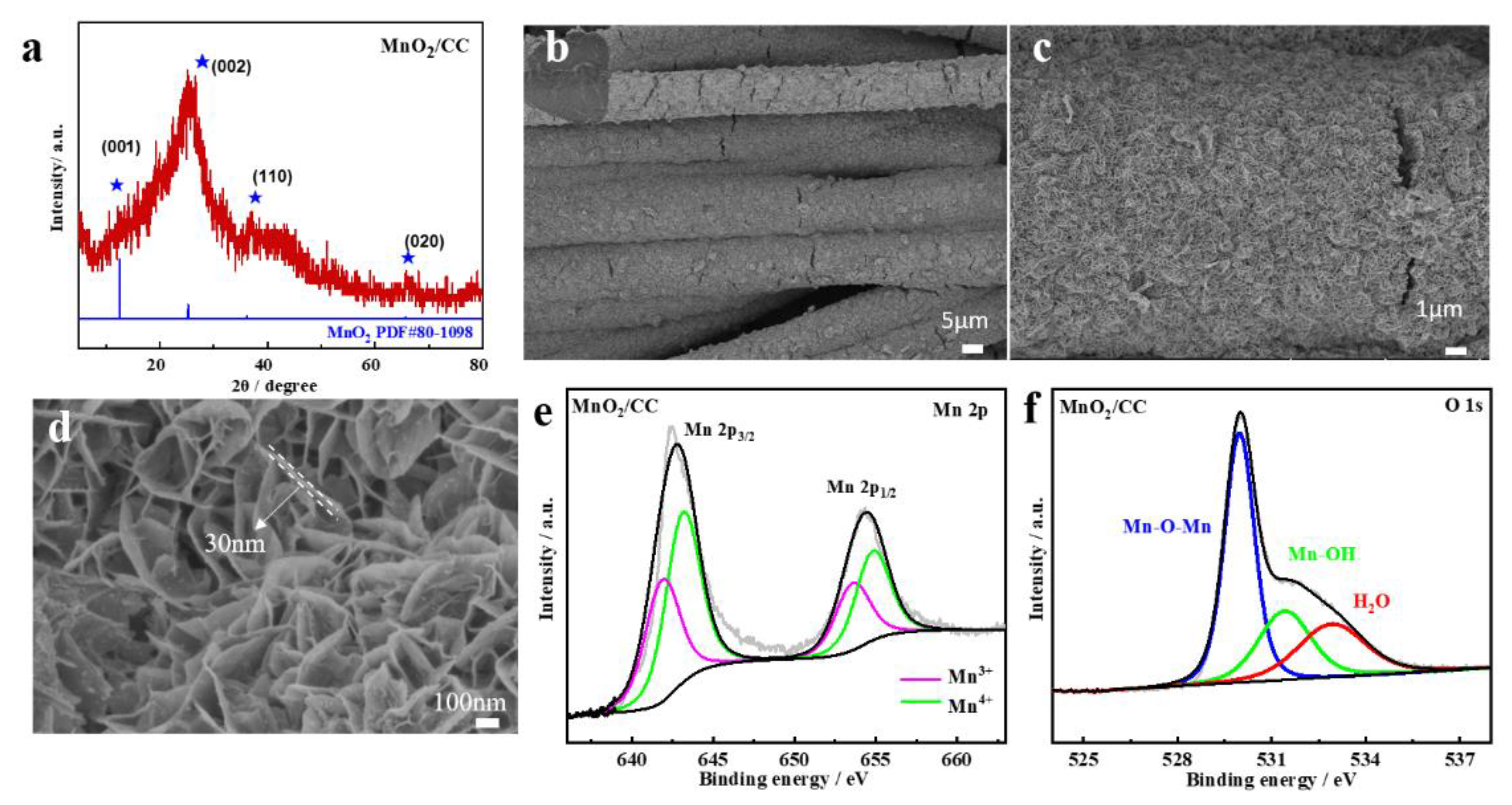
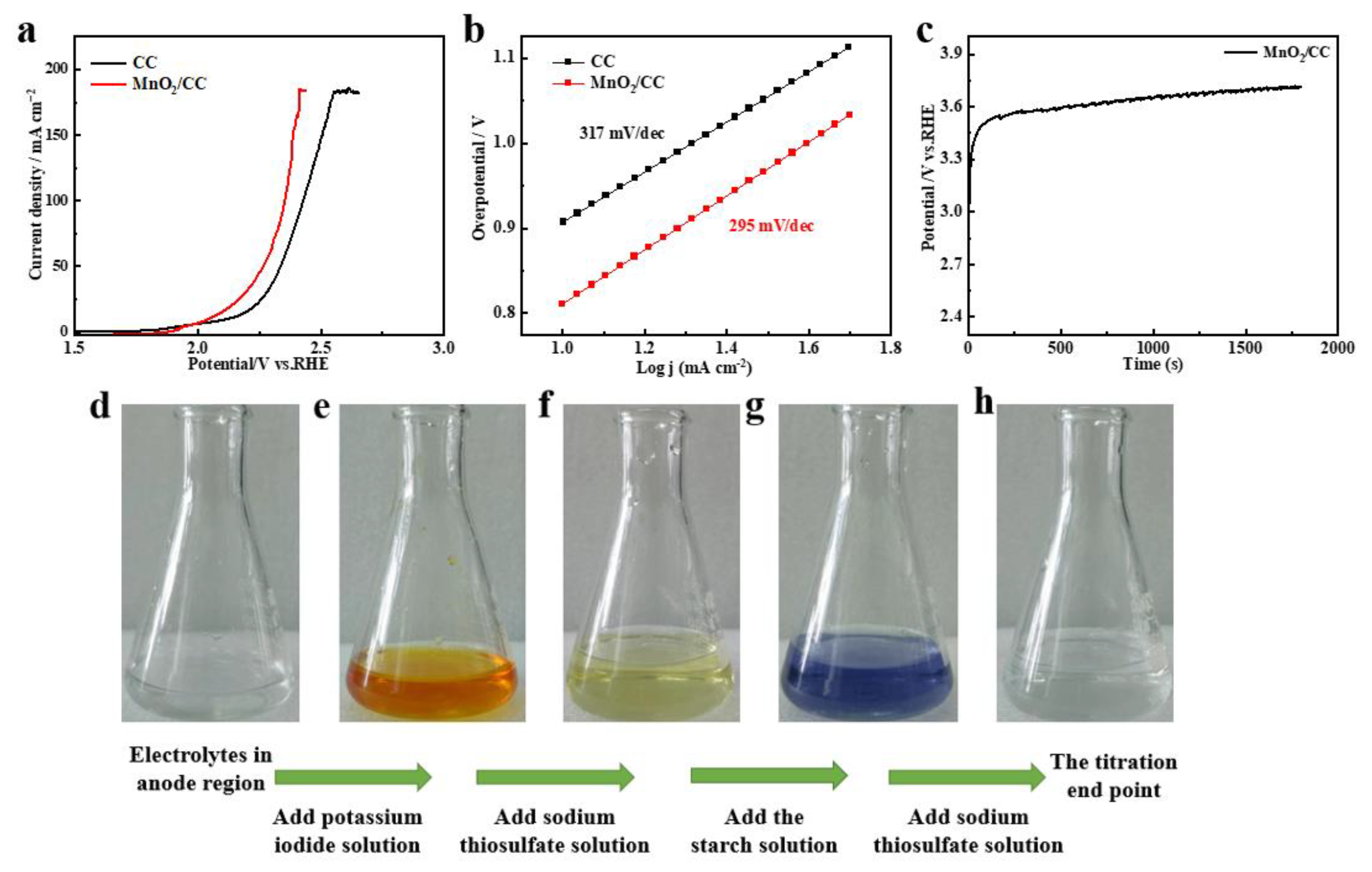
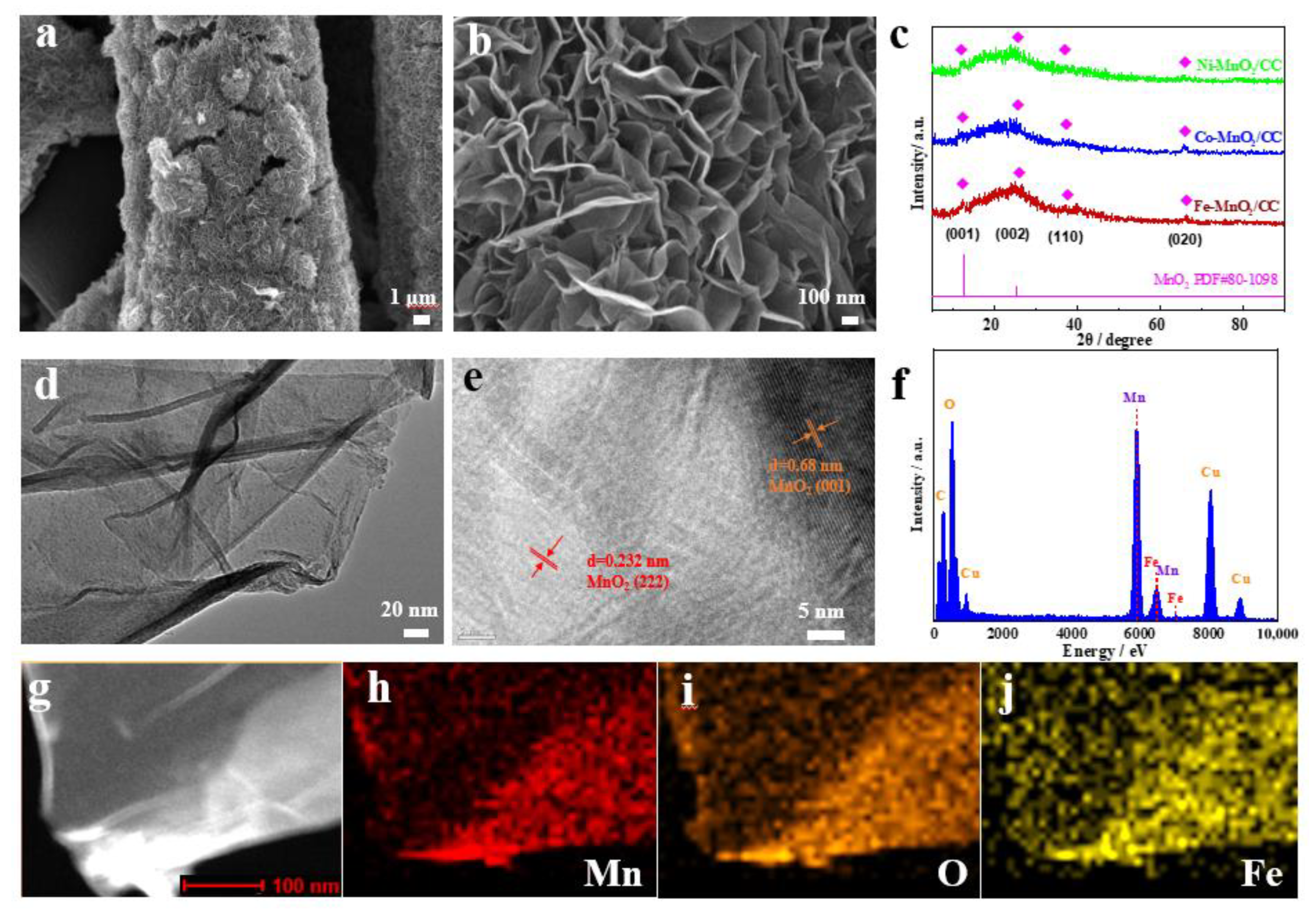
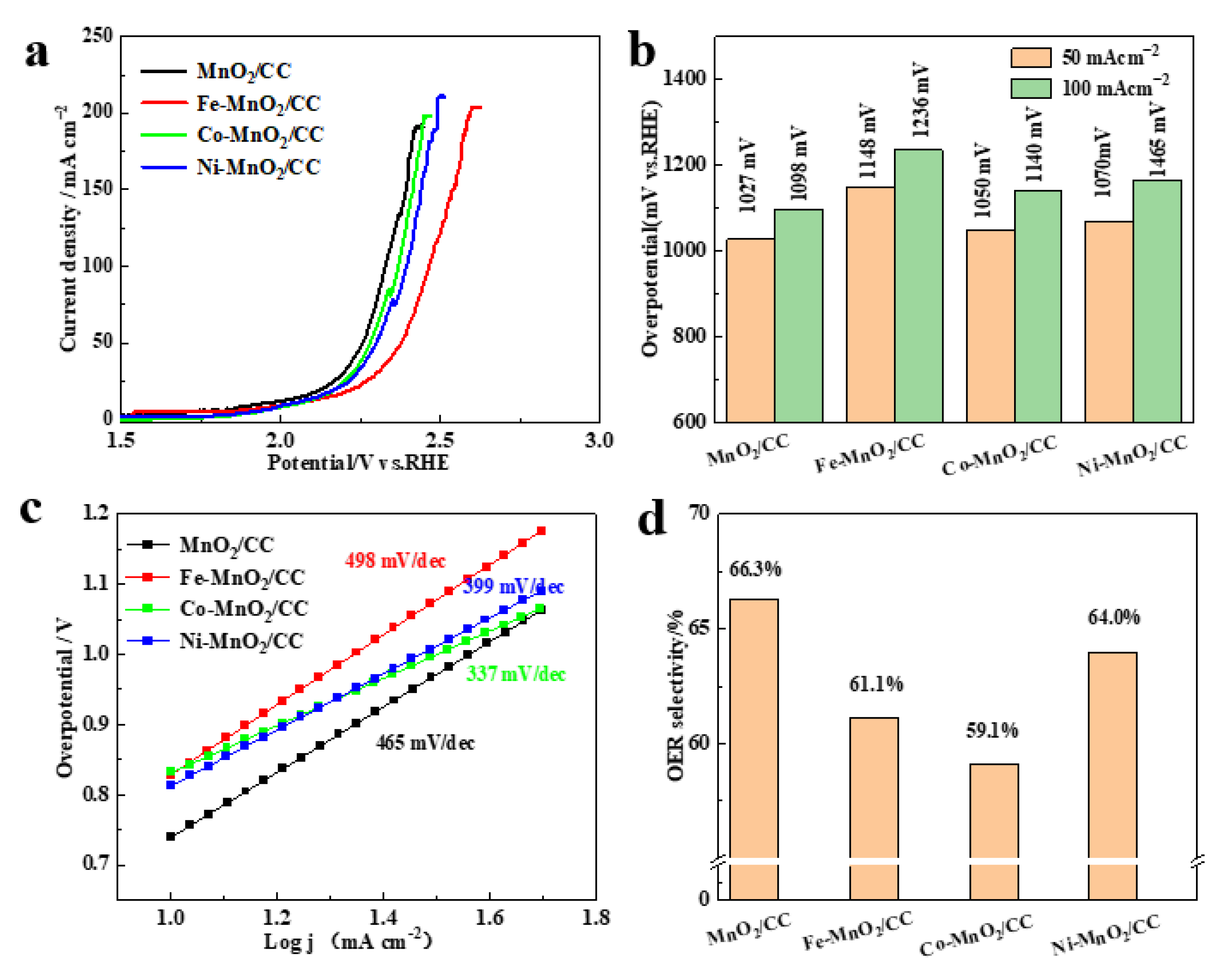
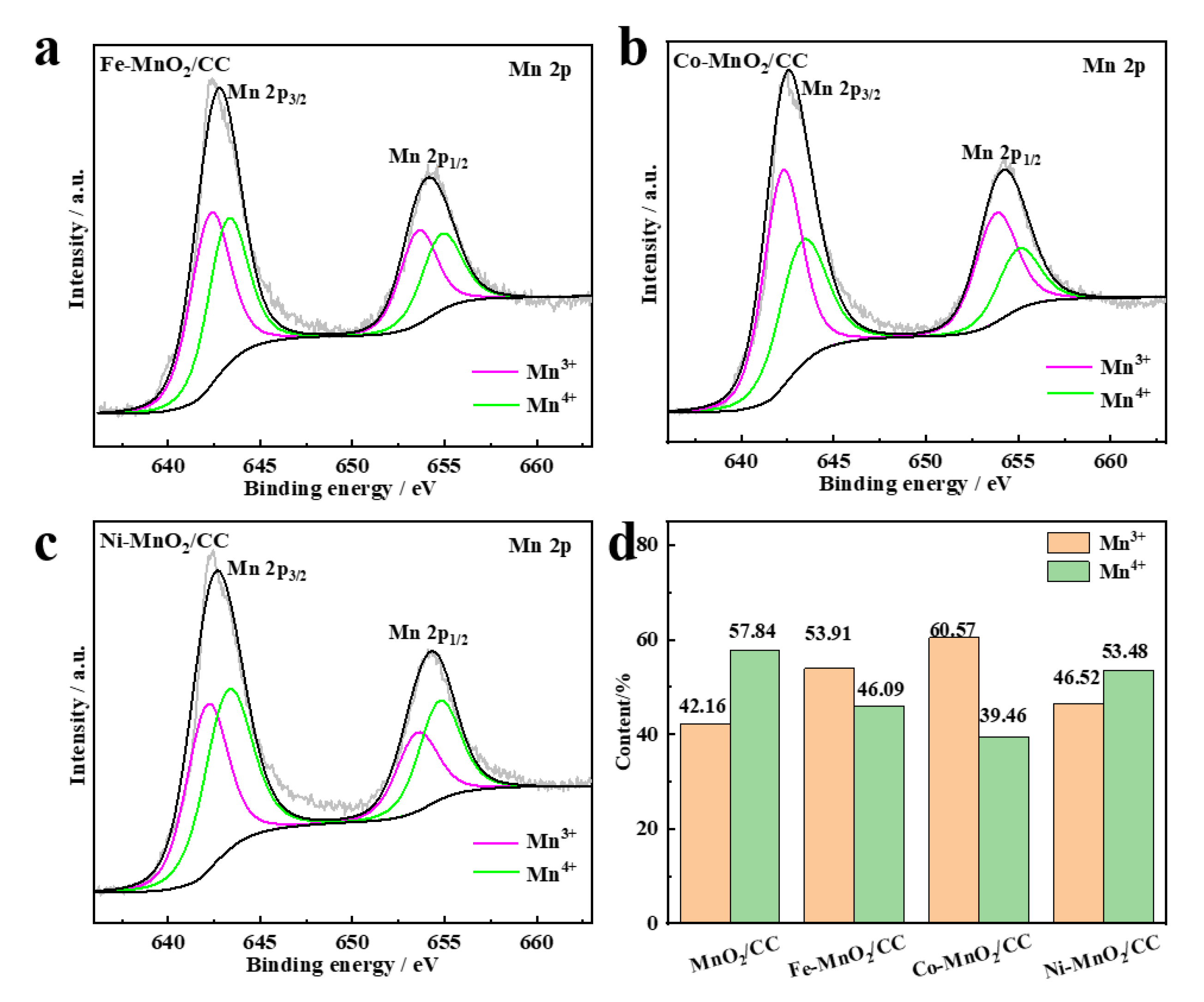
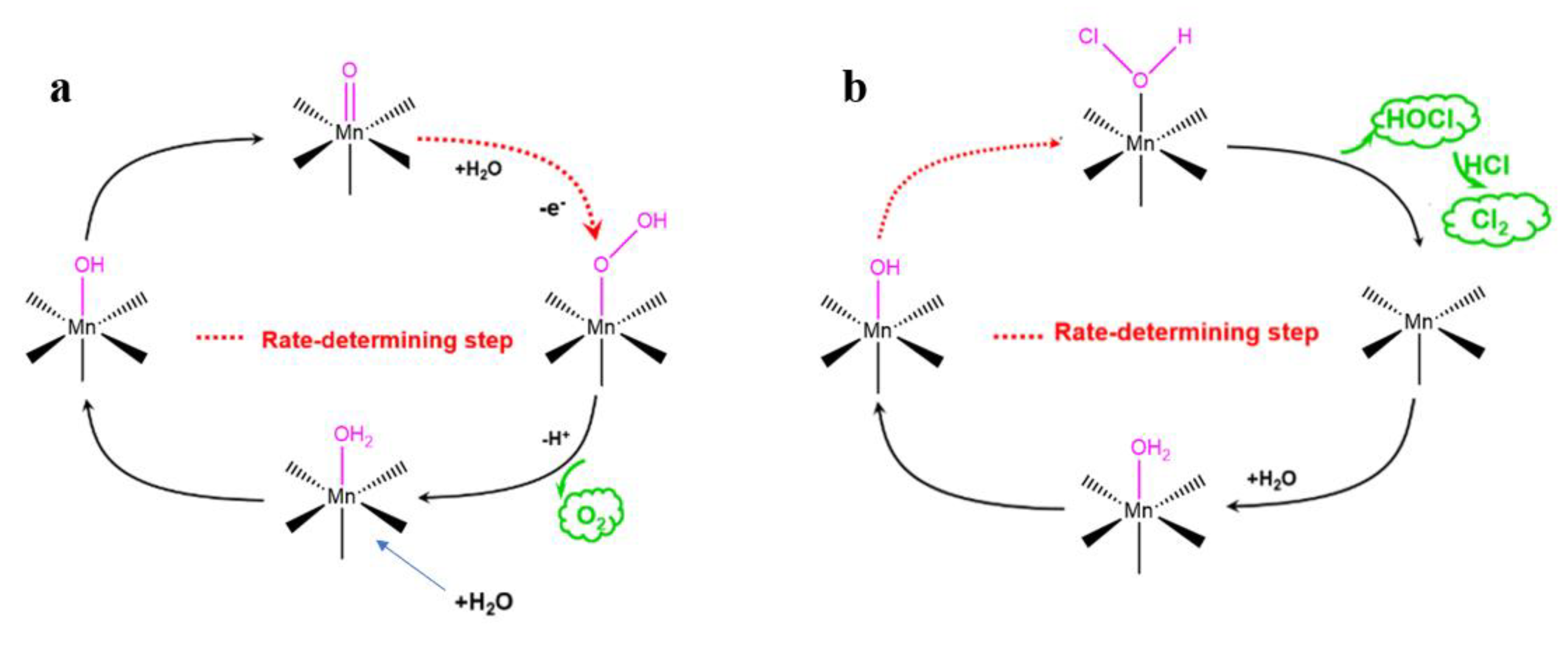
Disclaimer/Publisher’s Note: The statements, opinions and data contained in all publications are solely those of the individual author(s) and contributor(s) and not of MDPI and/or the editor(s). MDPI and/or the editor(s) disclaim responsibility for any injury to people or property resulting from any ideas, methods, instructions or products referred to in the content. |
© 2023 by the authors. Licensee MDPI, Basel, Switzerland. This article is an open access article distributed under the terms and conditions of the Creative Commons Attribution (CC BY) license (https://creativecommons.org/licenses/by/4.0/).
Share and Cite
Yan, H.; Wang, X.; Linkov, V.; Ji, S.; Wang, R. Selectivity of Oxygen Evolution Reaction on Carbon Cloth-Supported δ-MnO2 Nanosheets in Electrolysis of Real Seawater. Molecules 2023, 28, 854. https://doi.org/10.3390/molecules28020854
Yan H, Wang X, Linkov V, Ji S, Wang R. Selectivity of Oxygen Evolution Reaction on Carbon Cloth-Supported δ-MnO2 Nanosheets in Electrolysis of Real Seawater. Molecules. 2023; 28(2):854. https://doi.org/10.3390/molecules28020854
Chicago/Turabian StyleYan, Haofeng, Xuyun Wang, Vladimir Linkov, Shan Ji, and Rongfang Wang. 2023. "Selectivity of Oxygen Evolution Reaction on Carbon Cloth-Supported δ-MnO2 Nanosheets in Electrolysis of Real Seawater" Molecules 28, no. 2: 854. https://doi.org/10.3390/molecules28020854
APA StyleYan, H., Wang, X., Linkov, V., Ji, S., & Wang, R. (2023). Selectivity of Oxygen Evolution Reaction on Carbon Cloth-Supported δ-MnO2 Nanosheets in Electrolysis of Real Seawater. Molecules, 28(2), 854. https://doi.org/10.3390/molecules28020854



